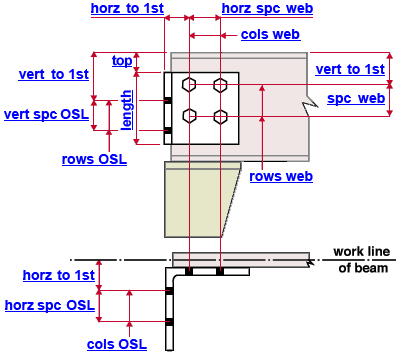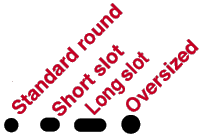"  Web Stability Angle " connection design locks
Web Stability Angle " connection design locks
| A " |
|
|||
|
" ( for a seated beam connection )  |
|
||
Connection Guide: Click here .
User Defined Connections: Settings that are locked (
) in a user defined connection file will automatically be locked on a member edit window for which that file is the " Input connection type ." You can, if you so choose, manually lock additional settings on the member edit window, and your changes will be retained, through multiple processes, so long as you do not change to a different connection then switch back to the original user defined connection.
Beam Edit: To change a setting, first set it to locked (
). Related settings that are unlocked (
) may be updated, and the "
Left/Right end limit state " calculations will be updated. Settings that are locked (
) will not be changed by connection design , even if doing so might prevent a connection failure.
Connection design locks :
| Options not shown on the drawing are marked ( not depicted ). |
![]() Web Stability Angle
Web Stability Angle
When " Stability Angle " = ' Field bolted ' and " Location " = ' Web '
Hole type web ( not depicted ): Standard round or Short slot or Oversized or Long slot or User slot #1 or User slot #2 . The hole type selected here, together with the " Bolt diameter " entered below, determine the diameter of holes on the leg of the stability angle that bolts to the web of the supported beam.

Rows web: The number of rows of holes in the leg of the stability angle that bolts to the web (see example ). If " Length of angle " is unlocked (
), changing the number of " Rows web " also changes the " Length of angle ."
Vertical to 1st hole web ( vert to 1st ) The distance from the top flange of the beam to the center of the nearest row of holes on the leg of the stability angle that bolts to the supported beam web (see example ). If " Length of angle " is unlocked (
), changing the " Vertical to 1st hole web " also adjusts the " Length of angle ." The " Top of angle " will not change. This distance is measured vertically if the column is perfectly vertical and the beam does not slope.
Vertical hole spacing web ( spc web ): The distance (as measured from the center of one hole to the next) between rows of holes in the leg of the stability angle that bolts to the web of the supported beam (see example ). If " Length of angle " is unlocked (
), changing the " Vertical hole spacing web " also changes the " Length of angle ." This distance is measured vertically if the column is perfectly vertical and the beam does not slope.
Columns web ( cols web ): The number of columns of holes on the angle leg that bolts to the web of the beam. For the example above, this number is ' 2 '.
Horizontal to 1st hole web ( horz to 1st ): The distance from the heel of the angle to the center of the first hole on the angle leg that bolts to the web of the beam (see example ). This distance is measured horizontally if the column is perfectly vertical and the beam does not slope.
Horizontal hole spacing web ( horz spc web ): The distance (measured center to center) between columns of holes in the leg of the stability angle that bolts to the web (see example ). This distance is measured horizontally if the column is perfectly vertical and the beam does not slope.
Hole type OSL ( not depicted ): Standard round or Short slot or Oversized or Long slot or User slot #1 or User slot #2 . The hole type selected here, together with the " Bolt diameter " entered below, determine the diameter of holes on the leg of the angle that bolts to the supporting column.

Rows OSL: The number of rows of holes in the leg of the angle that bolts to the column (the OSL). For the example above, this number is ' 2 '. If " Length of angle " is unlocked (
), changing the number of " Rows OSL " also adjusts the " Length of angle ."
Vertical to 1st hole OSL ( vert to 1st ): The distance from the top flange of the beam to the nearest hole on the leg of the angle that bolts to the column (the OSL). See example . If " Length of angle " is unlocked (
), changing the " Vertical to 1st hole OSL " also adjusts the " Length of angle ." The " Top of angle " will NOT change.
Vertical hole spacing OSL ( vert spc OSL ): The distance between holes on the leg of the angle that bolts to the column (the OSL). See example . If " Length of angle " is unlocked (
), changing the " Vertical hole spacing OSL " also adjusts the " Length of angle ."
Columns OSL ( cols osl ): The number of columns of holes on the leg of the angle that bolts to the column (the OSL). For the above example , this number is ' 2 '.
Horizontal to 1st hole OSL ( horz to 1st ): The distance from the work line of the beam to the center of the first hole on leg of the angle that bolts to the column (the OSL). See example . The distance is measured horizontally if the column is perfectly vertical and the beam does not slope.
Horizontal hole spacing OSL ( horz spc OSL ): The distance between columns of holes on the leg of the angle that bolts to the column (the OSL). See example . This setting applies when the stability angle has more than one " Columns OSL ." The distance is measured horizontally if the column is perfectly vertical and the beam does not slope.
Material ( not depicted ): The section size of the angle material to be used for the stability angle. For example, L4x3x5/16. The angle you enter here must exist in the local shape file, or validation will not accept your entry. To enter an angle section size, you can type in the section size that you want, or you can press the "file cabinet" browse button (
) and double-click any section that is on the list of available angles in the local shape file .
Long leg to ( not depicted ): Supported or Supporting . If you want the long leg of the angle to attach to the supporting column, select ' Supporting '. If you want the long leg of the angle to attach to the web of the supported beam, select ' Supported '.
Top of angle ( top ): The vertical distance from the top flange of the beam to the top edge of the angle (see example ). Changing " Top of angle " moves the angle only and does not the change the location of the holes. If " Length of angle " is unlocked (
), changing the " Vertical to 1st hole web " or " Vertical to 1st hole OSL " moves the holes and adjusts the " Length of angle ."
Length of angle ( length ): The distance between the top edge of the angle and the bottom edge of the angle (marked " length " in the example ). If " Length of angle " is unlocked (
), changing the number of ' Rows web ' or the ' Vertical hole spacing web ' or the ' Vertical to 1st hole OSL ' or the number of ' Rows OSL ' or the ' Vertical hole spacing OSL ' also causes connection design to adjust the ' Length of angle '.
Bolt diameter ( not depicted ): The diameter of bolts for both legs of the stability angle. You can either type in any diameter (inches or mm), or you can select a bolt diameter from the combo box (
). The diameters that are listed in the combo box come from Home > Project Settings > Job > Bolt Settings > the " Available bolt diameters " list. The bolt diameter selected here, together with the " Hole type web " or " Hole type OSL ," set the diameter of holes the bolts go into.







